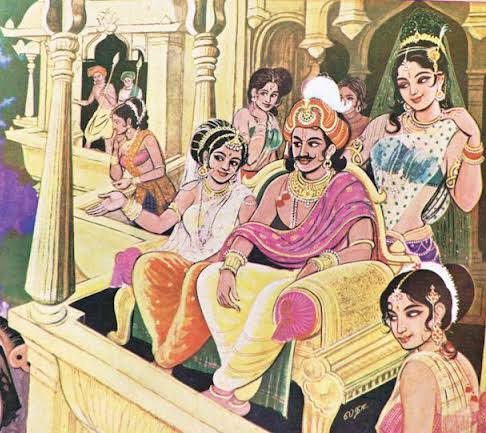By: Barnali Bose, Editor-ICN Group
KOLKATA: One often hears that in today’s world, man has lost his ability to remain content with one partner all his life. In other words,treading beyond conjugal ties is a relatively new phenomenon corroding the foundation of marriage in the modern world.
I would but beg to differ with such a view as History has a different story to tell. Fidelity to one partner has been probably desired but quite often proved to be elusive. Had man been satisfied in a monogamous relationship in the days of yore ?
Let us trace the evolution of man-woman relationship from the yesteryears to now to unearth the facts.
In the prehistoric age, man-woman relationships did not exist within the confines of Matrimony.Men were free to choose and change their partners for emotional and physical gratification. The institution of Marriage was unknown to them.
It is to be understood, that this often became the bone of contention leading to fierce encounters.
With settled life, Marriage was introduced in order to enforce restraint upon changing partners too often, perhaps to induce some sort of accountability into relationships as well as maintain amiability among tribesmen.
Not only that, the fatherhood of children that often remained unknown or debatable got social recognition owing to the institution called marriage.
Polygamy( having more than two spouses) and bigamy(having two wives) existed for a long time. It is known that men belonging to the privileged class namely kings and princes practised Polygyny(having multiple wives) and bigamy whereas nobles and rich landowners or zamindars practised not only monogamy( having one wife) but also bigamy.
Besides, the lure of the forbidden fruit was often found to be difficult to overcome. Thus, men of higher ranks often visited courtesans, who were provided with all material benefits but had to forego social acceptance.Monogamy was widely in vogue mostly among the common people.
Polygyny was very common amongst Mughal rulers. Akbar, the great, is believed to have had a hundred wives in his harem and his undivided dedication to Jodha Bai as portrayed on screen was quite reverse to the historical truth.
In fact, History seems to have had no queen by this name although Akbar did marry a Rajput princess or more than one to win the trust of the powerful Rajputs.
Polyandry( having many husbands) was practised at the dawn of human civilisation almost worldwide. It was in vogue in the Indian subcontinent, in the Canadian Arctic and in parts of Africa, China and the Americas
The custom evolved in human cultures where resources, particularly land and food, were scarce,or where women owned property or ancestral titles of rank.
Polyandry was imposed upon Draupadi, who though married to Arjuna, had to be wife to the five Pandavas.
Another form of marital union called secondary marriage existed when a married woman cohabited with a man other than her husband. This was the accepted rule when the husband was incapable of fathering a child.
In the Mahabharata, Pandu had two wives,Madri and Kunti.He was however unable to father any of the five Pandavas owing to a curse by a hermit. Thus, the Pandavas were born of different fathers.
Yudhishthira’s father was Yama; the father of Bheem was Vayu; the father of Arjun was Indra whereas Nakul and Sahadev were the divine Ashwini twins. Kunti had also become the unwed mother of Karna,her first-born, who was Surya’s son.
In some parts of the world, polyandry prevailed in areas where the man-woman ratio was widely uneven. It was for example prevalent in cultures where female infanticide was the norm rather than an exception.
Polyandry allowed men to live comfortable lives. In these relationships, women enjoyed a high status.
It has been known that in some ancient Celtic societies, women were allowed to own property and therefore marry more than one man.
Thus the law of the land not only permitted more than one partner but gave social sanction to it. And in almost all cases, the polyandry practised was fraternal, wherein brothers had a wife in common.
Around 2300 BCE, the Sumerian king Urukagina of Lagash abolished the custom of polyandry entirely in Mesopotamia. Polyandry was also prohibited successively by the monotheistic faiths namely Judaism, Islam and Christianity.
In a few regions of India, Bhutan, Nepal and Tibet, the custom of polyandry continued until recently, among some minorities.
While the custom has now been banned in Tibet by Chinese authorities, in India, the practice seems to have faded into oblivion on its own.
Maybe increasing resources and job opportunities facilitated men to leave resource-poor areas and find jobs and wives elsewhere.
Polygamy is almost non-existent now. Bigamy is outdated too although some societies still give legal sanction to it. The world or rather the outlook of the people has changed. Man apparently seems to be at ease in a monogamous marriage.
There is a counter view that suggests the imposition of Monogamy was responsible for man’s drifting into adulterous relationships or being cuckolded by their wives.
Fear of social contempt often keeps relationships beyond monogamy under wraps.It would, in my opinion, be wishful thinking to generalise man-woman relationships as monogamous in nature. It hasn’t always been so and perhaps will never always be. However, my readers have the freedom to agree or disagree with me.




